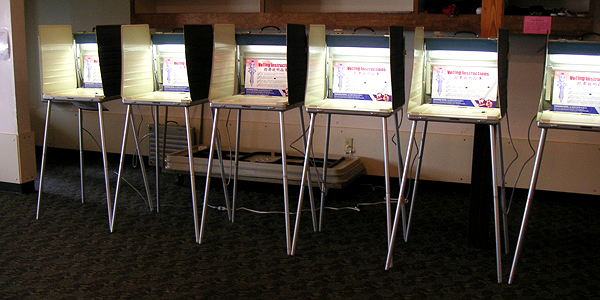
(Photo Credit: Eyspahn/Flickr)
The headline of this story is a little misleading. Residents in 15 cities in Los Angeles County had the opportunity to head to the polls last Tuesday, but few actually did.
Turnout in the City of Los Angeles, for example, was a paltry 8.6 percent, according to initial tallies. Out of 1.8 million registered voters, less than 160,000 cast ballots.
I knew the election had gone all but unnoticed when I walked into my polling place on Tuesday afternoon around 5 p.m. and saw no one but four bored poll workers.
One of them said to me, “You’re the first person without gray hair to come in and vote today.”
When I asked how many voters had cast ballots in the ten hours that they’d been open, one said, “You make 23.”
My CA Fwd colleague Ed Coghlan had a similar experience. Once he figured out which polling place he was supposed to go to (he went to the wrong one first), he walked into a church basement just before 8 a.m. and discovered that he was lucky voter number one.
“The poll workers couldn’t have been nicer,” he said. “I think they were glad to see anyone with a pulse.”
After voting, he went to the local Starbucks for his morning caffeine fix and had to wait in line, causing him to wonder whether we should allow voting booths in coffee shops. And if even that doesn’t bolster turnout, at least the crowds would prevent poll workers from feeling so lonely.
The local media in Los Angeles was looking at the issue too. Carlos Granda of ABC7 Eyewitness News filed this report on the election with one important feature missing: voters.
Campaign consultants, though, might not necessarily view that as a negative. It’s much easier to win elections when turnout is low and messaging can be targeted to a much smaller and predictable sector of the electorate.
Take for instance the race for Los Angeles Sixth District City Council seat. Of the district’s roughly 93,000 registered voters, preliminary numbers show fewer than 9,000 cast ballots. That’s a turnout rate of 9 percent. As a result, Nury Martinez maintained her seat on the Los Angeles City Council by garnering roughly 5,000 votes.
Decisions made by elected officials at the local level have the greatest direct impact on people’s lives. When only a small unrepresentative group of the community elects these decision makers, it can distort the perceived policy preferences of the electorate. Likely voters and non-voters tend to differ in their political views.
Instead of hoarding the power for themselves, the few hardy souls who did turnout voted for measures that could bring more of their fellow Angelenos into the political process. More than 76 percent of voters approved two charter amendments designed to boost voter participation by shifting L.A. city and school district elections from odd to even years to coincide with state and federal elections.
The election calendar has a significant impact on voter participation and representation. While participation in municipal elections is notoriously low, turnout in odd-year elections is generally even lower and less representative of the broader electorate. Simply aligning local elections with the state and federal election cycle can boost local turnout by 21-36 points, according to a recent report released by California Common Cause.
But election consolidation alone won’t solve California’s turnout problem. A number of solutions are required to improve California’s alarmingly low voter participation rate.
The good news is that the Future of California Elections (FoCE) is on the case. This coalition of election officials, civil rights organization and election reform advocates, including CA Fwd, is actively working to identify and promote policy solutions aimed at making California’s democracy more inclusive and robust.
In fact, more than 250 policymakers, researchers, election officials and voter advocates gathered in Sacramento at the third annual Future of California Elections Conference last month to discuss the challenges and innovations in the field of elections. The conference focused on three key areas of FoCE’s work to improve California’s election system:
“1. Access to voter registration – as the state continues to expand online voter registration, there are countless ways to ensure that every eligible Californian has the opportunity to register to vote or update their record, whether at government agencies or other entities like public utilities or private businesses;
2. Voting experience – as California becomes more diverse, it is vital that the election system be accessible to all voters regardless of English proficiency or disability – with information available in print and online in plain language usable by each individual voter; and
3. Election administration – as California’s election system continues to undergo tremendous change, from the expansion of vote-by-mail to include new voting options to new development of new voting technology – it is crucial that local election offices get sufficient guidance and funding from the state to carry out state election law.”
Although last Tuesday was another disappointing day in Los Angeles, no other state can boast having such a comprehensive statewide collaborative working to improve the electoral process.
The health and legitimacy of our representative democracy depends on expanding the electorate to ensure all of California’s diverse voices are heard. A vibrant and responsive democracy is necessary to improve how we make decisions because more than 90 percent of eligible voters staying home is neither vibrant nor responsive.

